by Randall D. Larson
Remembering classical/film composer and conductor Don Terryl (Terry) Plumeri, who, tragically, was found murdered, apparently by burglars, in his home in Dunnellon, Florida on April 1, 2016. Plumeri was 71. Investigators believe the composer’s murder to be connected to a string of daytime burglaries that have been occurring in the area recently.
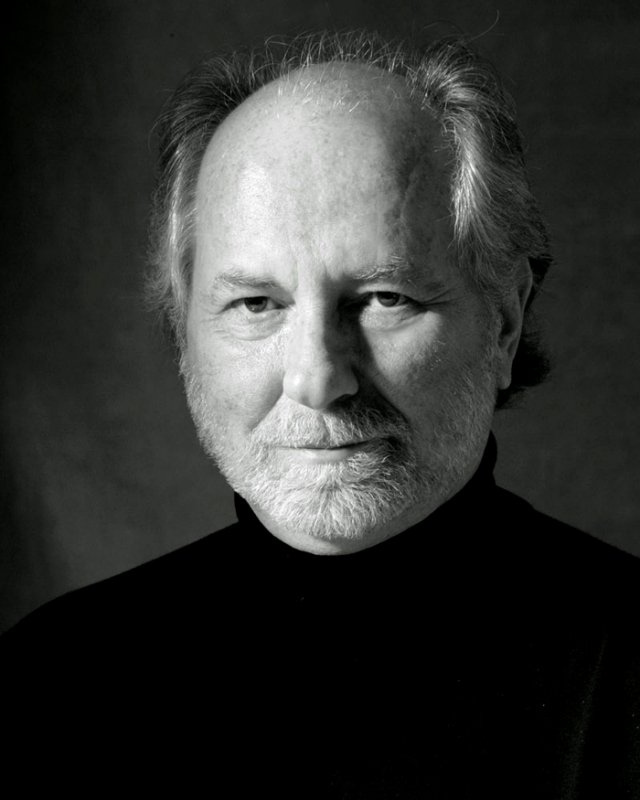 Well known for his conducting of classic concerts and his own compositions (often using the name Johnterryl Plumeri), equally regarded as a jazz musician (he played bowed bass and released several jazz albums), he was also a prolific composer of more than 50 film scores. Most of those scores tended to be for low-budget genre films, but he gave them high-quality and sophisticated orchestral treatments whenever possible.
Well known for his conducting of classic concerts and his own compositions (often using the name Johnterryl Plumeri), equally regarded as a jazz musician (he played bowed bass and released several jazz albums), he was also a prolific composer of more than 50 film scores. Most of those scores tended to be for low-budget genre films, but he gave them high-quality and sophisticated orchestral treatments whenever possible.
In recent years several of his scores have been released on soundtrack albums (Intrada Records and KeepMoving Records were particularly notable champions of his film work) or promotional CDs produced by Plumeri himself. I remember Terry as a gentleman, enthusiastic and sophisticated about music, a classicist who never looked down on film scoring and who regarded his opportunities in cinema music as equally of creative value to his concert material, although clearly he favored the latter as his life’s legacy.
What follows, in tribute to and remembrance of Terry Plumeri and his music for film, specifically for the horror and supernatural genres, is the segment I wrote for Musique Fantastique, Second Edition, when I completed my first final draft. As the book series continues with the second book appearing later this year or early next, the book and chapter sequence will change, and this section on Terry’s fantasy/horror scoring will be updated, including having to add the sad fact of his death. But as it stands now, here’s how I have covered Terry’s work in the musique fantastique genre, largely based on our 2009 interview.
[To read the interview in its entirety, which also includes non-genre films such as DEATH WITH V, ZERO OPTION, LOVE TAKES WING, NATE AND THE COLONEL, ONE FALSE MOVE, and others, see my June 2010 Soundtrax column]
Respectfully, Randall D. Larson
Terry Plumeri first became interested music at the age of 10 and went on to attend The Manhattan School of Music in New York City on scholarship. He studied with Robert Brennand, principal bass of the New York Philharmonic, and became a bassist with the National Symphony Orchestra in Washington D.C. Afterwards, he studied composition and conducting with the Hungarian conductor/composer Antal Dorati, himself a student of the legendary Bela Bartok. Since 1988, Plumeri has written the music to nearly 60 feature films while also maintaining a prolific career as a composer and conductor of both the classical repertoire and jazz.
“The biggest drawback about film music is that the journey from beginning to end is pre-defined when you enter,” Plumeri told me in an August 2009 interview. “As a film composer, you are a psychological colorist to someone else’s architecture. Although as a colorist you can make serious contributions to the existing journey, in the end, it never compares to creating and coloring your own structure.”
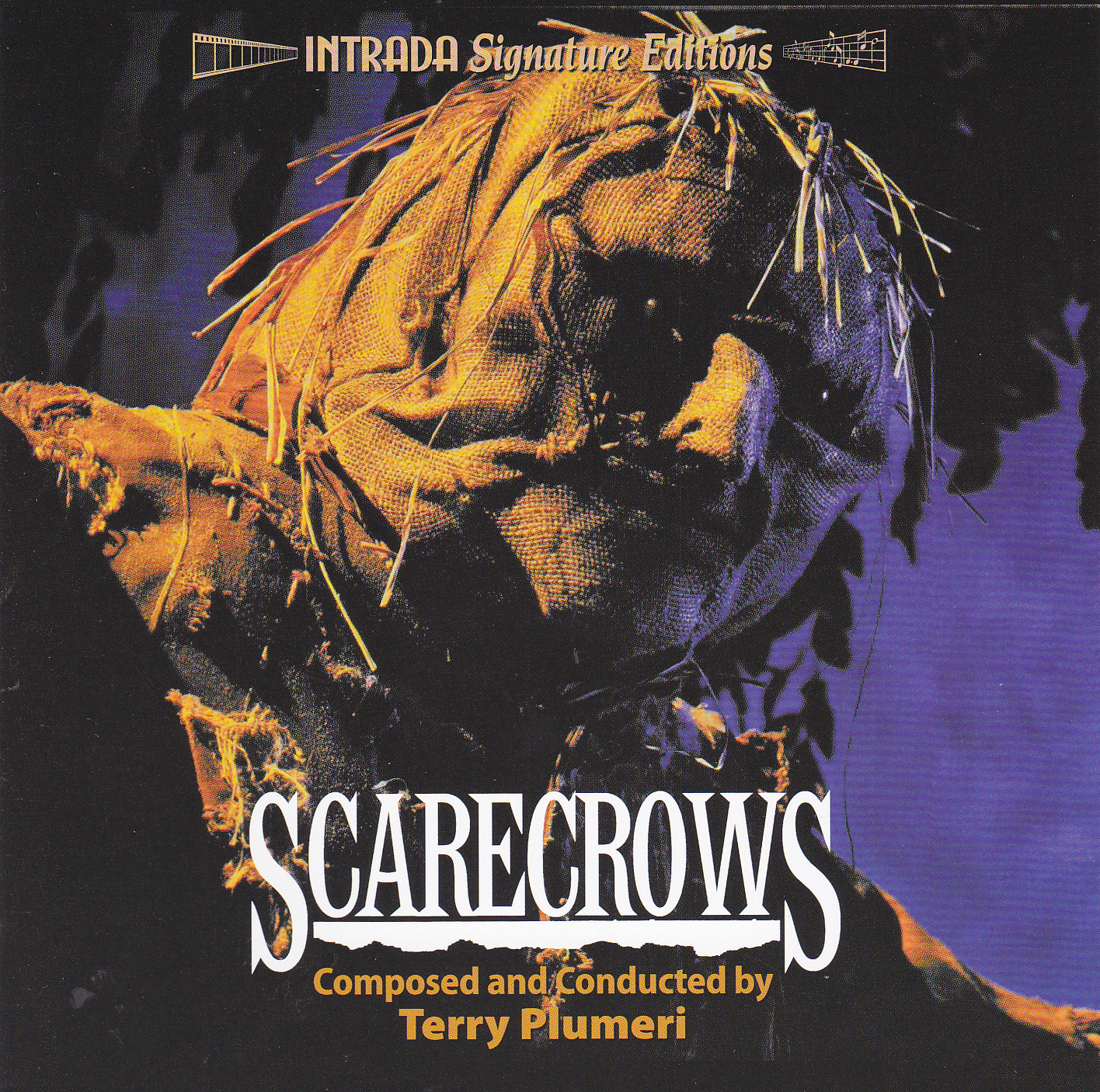 After having spent many years ghostwriting more than twenty film scores for other composers, Plumeri’s first film score under his own name was for the horror film SCARECROWS (1988), a grisly yarn directed by William Wesley about criminals pulling a heist who hole up in a small town whose scarecrows are far more than mere straw and cloth. The score provides a range of tonal color and instrumental depth that belies its small number of players, giving the story a continual forward motion that intensifies its excitement and suspense. With stick-percussion clacking and rustling about as the main title opens, the score suggests the shifting of straw and twine in the movement of a Scarecrow, while the resolute string measures and pounding drums crafts an immediate sensation of foreboding and evil resolve just as the movie is getting underway. Plumeri’s low piping flutes and guttural groaning clarinets, pensive harp figures, and ongoing percussion continues to suggest the peril that awaits our criminals as they head toward the farm.
After having spent many years ghostwriting more than twenty film scores for other composers, Plumeri’s first film score under his own name was for the horror film SCARECROWS (1988), a grisly yarn directed by William Wesley about criminals pulling a heist who hole up in a small town whose scarecrows are far more than mere straw and cloth. The score provides a range of tonal color and instrumental depth that belies its small number of players, giving the story a continual forward motion that intensifies its excitement and suspense. With stick-percussion clacking and rustling about as the main title opens, the score suggests the shifting of straw and twine in the movement of a Scarecrow, while the resolute string measures and pounding drums crafts an immediate sensation of foreboding and evil resolve just as the movie is getting underway. Plumeri’s low piping flutes and guttural groaning clarinets, pensive harp figures, and ongoing percussion continues to suggest the peril that awaits our criminals as they head toward the farm.
“SCARECROWS was a great experience in many ways, and still one of my favorites when I look back at my work of the past,” Plumeri explained. “Because of the budget for SCARECROWS, I was limited to thirteen instruments. I chose to use an augmented string quartet (2 violins, 2 violas, cello and double bass), four woodwinds with doubles (Eb contrabass and Bb bass clarinets, Bb clarinet, Eb clarinet, bass, alto and C flute, English horn and oboe), harp, piano, and percussion. I was fully experienced in writing music for large orchestra at that point, and had also written a number of chamber works. So it wasn’t a new thing for me to accomplish dramatic impact with a small group of instruments.”
After scoring a handful of action thrillers, Plumeri scored THE TERROR WITHIN II (1991), sequel to the 1989 post-apocalyptic thriller that had been scored by Rick Conrad. “The film’s primitive, almost biblical environment called to mind some of the flavors of those biblical scores of the past,” Plumeri said. “The score was a combination of that plus the vocabulary needed to accompany the mutant monster. That film also became a doorway into Stephen King’s SOMETIMES THEY COME BACK because the director heard THE TERROR WITHIN II, liked it a lot, and called me. That’s how I ended up getting the job.”
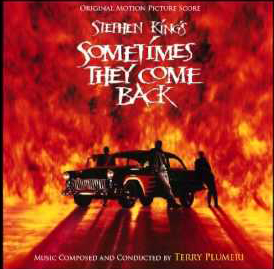 Based on King’s short story, SOMETIMES THEY COME BACK was about an individual returning to his home town after 25 years and being harassed by the ghosts of former friends, and his older brother, who had also died and come back. “There was this whole element of the family flashbacks of the two brothers when they were children,” said Plumeri. “The main theme was one that needed to convey brotherly love. I intended this music to have a childlike innocence. In contrast to that was some severely dark and creepy tension that was needed to accompany the ghost element. It was another one of those films that became an education in the sense that you were balancing family innocence and beauty with dark and creepy horror, and being able to make the proper transitions out of one into the other.”
Based on King’s short story, SOMETIMES THEY COME BACK was about an individual returning to his home town after 25 years and being harassed by the ghosts of former friends, and his older brother, who had also died and come back. “There was this whole element of the family flashbacks of the two brothers when they were children,” said Plumeri. “The main theme was one that needed to convey brotherly love. I intended this music to have a childlike innocence. In contrast to that was some severely dark and creepy tension that was needed to accompany the ghost element. It was another one of those films that became an education in the sense that you were balancing family innocence and beauty with dark and creepy horror, and being able to make the proper transitions out of one into the other.”
In contrast was the Disney channel feature, STEPMONSTER (1993), about a step mother who from time to time turned into a monster and ate some of the neighborhood kids as well as the adults. “That was tongue-in-cheek horror,” Plumeri said. “It’s one thing to write family music and one thing to write horror music, but to write horror music with a smile is another ballgame. That film was also one of those films that was a real education musically; I walked away from that film having expanded my vocabulary and my understanding of a specific musical accompaniment.”
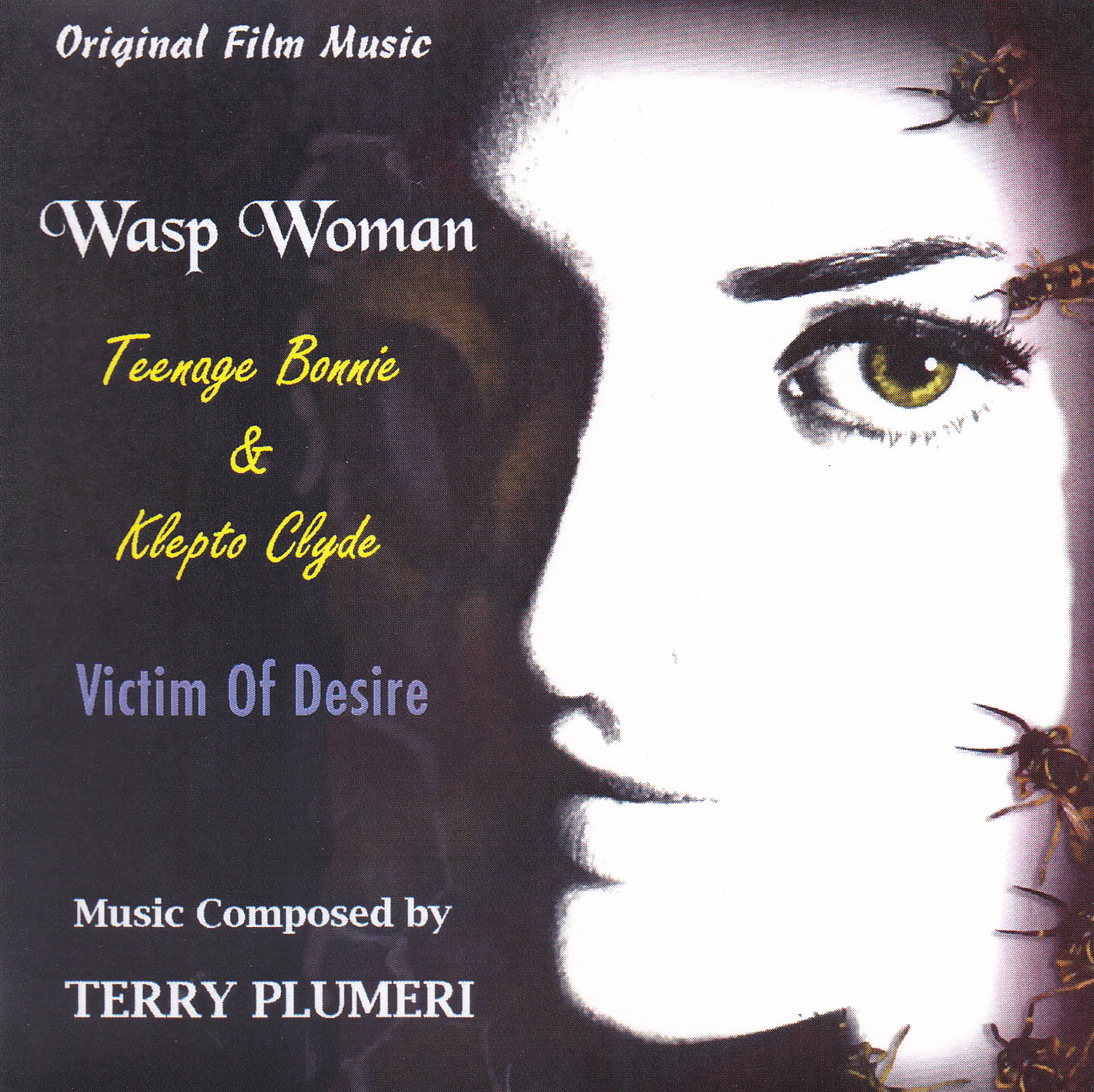 Plumeri scored Jim Wynorski’s WASP WOMAN (1995), a remake of the 1960 Roger Corman film about an aging model who takes a new youth serum based on wasp hormones, unaware that the after effects will give her an unexpected buzz. The film’s budget required this to be a synthesizer score based on sampled orchestrations. “I had one of the worst deadlines I ever experienced on WASP WOMAN,” Plumeri said. “There was approximately one week to do the work and there was well over an hour of music to be written. I chose a dark waltz which had lots of tension and strange effects for the Wasp Woman theme. Before the transition to the monster, she was a beautiful woman. So, it required music that possessed elegant beauty but at the same time, also had darkness to it. The result was a demented and twisted waltz, intended to convey the torment of a beautiful woman caught in her worst nightmare. It was certainly another musical education to delve into this horrific elegance.”
Plumeri scored Jim Wynorski’s WASP WOMAN (1995), a remake of the 1960 Roger Corman film about an aging model who takes a new youth serum based on wasp hormones, unaware that the after effects will give her an unexpected buzz. The film’s budget required this to be a synthesizer score based on sampled orchestrations. “I had one of the worst deadlines I ever experienced on WASP WOMAN,” Plumeri said. “There was approximately one week to do the work and there was well over an hour of music to be written. I chose a dark waltz which had lots of tension and strange effects for the Wasp Woman theme. Before the transition to the monster, she was a beautiful woman. So, it required music that possessed elegant beauty but at the same time, also had darkness to it. The result was a demented and twisted waltz, intended to convey the torment of a beautiful woman caught in her worst nightmare. It was certainly another musical education to delve into this horrific elegance.”
Plumeri’s score for NIGHT HUNTER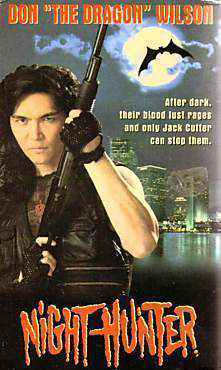 (1996), a vampire slayer thriller starring Don “The Dragon” Wilson, was based on a flamenco guitar motif (performed by Federico Ramos) along with sampled strings sweetened by a small ensemble of real strings. “Don Wilson played a vampire hunter and wore a long, dark, ambient coat which immediately conveyed ‘gypsy’ to me,” he said. “That’s what I saw for him. I knew that I would either be criticized or loved for it and I’ve heard both! But it worked for me and it made the film much more stylized, because his flavor was flamenco.” While the flamenco music characterized Wilson’s character and his vampire hunter ancestry, Plumeri created compelling horror elements with his strings. “In the fight scenes with the vampires, there was a combination of intense flamenco guitar and string quartet which actually gave a lot of energy,” Plumeri said.
(1996), a vampire slayer thriller starring Don “The Dragon” Wilson, was based on a flamenco guitar motif (performed by Federico Ramos) along with sampled strings sweetened by a small ensemble of real strings. “Don Wilson played a vampire hunter and wore a long, dark, ambient coat which immediately conveyed ‘gypsy’ to me,” he said. “That’s what I saw for him. I knew that I would either be criticized or loved for it and I’ve heard both! But it worked for me and it made the film much more stylized, because his flavor was flamenco.” While the flamenco music characterized Wilson’s character and his vampire hunter ancestry, Plumeri created compelling horror elements with his strings. “In the fight scenes with the vampires, there was a combination of intense flamenco guitar and string quartet which actually gave a lot of energy,” Plumeri said.
William Wesley’s ROUTE 666 (2001), a gangster thriller which puts a mob informant on the run against a gaggle of zombies in the Arizona desert, was one the few times Plumeri felt the need to adhere to someone else’s desire for the music. “It was a horror film and one that mistakenly took place in the daytime,” he said. “As you might guess, it’s a little tougher to achieve frightening monsters in the daytime than it is in the night! I visualized it much more frightening with an orchestra score, and there was enough money to have done it that way. But they somehow had a need to have heavy metal rock and roll instead. I accepted that and I did it as best I could and it works well in a lot of ways, but…it doesn’t have the mystery and the horrific intentions that can come out of a well written orchestra score.” Instead, Plumeri achieved a spooky atmosphere using tonalities reminiscent of the electronic flavors from sci-fi films of the 1950s.
ROUTE 666 was Plumeri’s last horror score to date, the balance of the decade occupied with adventure films and dramas, and considerable effort paid to his classical and jazz interests. But Plumeri’s music for fantasy horror films has been notable, demonstrating a calculated effort in supporting the unique nuances of the genre with music. “The events in fantasy and horror generally require a more extended style of melodic, harmonic, and rhythmic expression,” Plumeri said. “The freedom involved is probably one of the greatest elements about doing the work. I do a good bit of research before I write a score, generally to expand my vocabulary so that I’m capable of properly expressing the visual and writing something I’ve never written before. One of the great things about doing a film is the education that you receive. Every time you go into one of those projects you walk away knowing more about yourself as a composer than you did before, and you’ve displayed something musically that you’ve never shown before – and hopefully, maybe something that is brand new, so that in some small way, you’ve made a contribution of some sort.”
LINKS TO LISTEN – Samples of Terry Plumeri’s music on YouTube:
Suite from NATE AND THE COLONEL (2003, Western)
Love Theme from RAGING ANGELS (1995, Horror Thriller)
Main Title Music from LOVE TAKES WING (2009, Family Western)
Finale & Aftermath from SOMETIMES THEY COME BACK (1991, Horror)
End Credits from BLACK SEA RAID (2000, Action)
Main Title, DEATH WISH V (1994, Crime Thriller)





